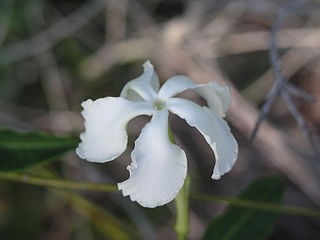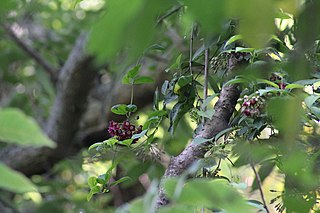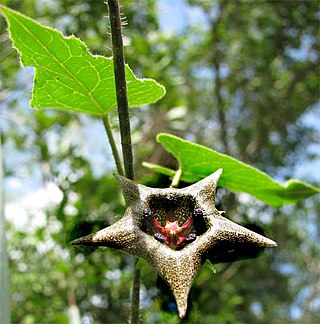
Milla, the Mexican star, is a genus of monocotyledonous plants in the family Asparagaceae, subfamily Brodiaeoideae. They are native mostly to Mexico, with one species extending into Guatemala, Honduras, Arizona, Texas and New Mexico.

Aspidosperma megalocarpon is a species of plant in the family Apocynaceae. It can be found in Belize, Colombia, Ecuador, El Salvador, Guatemala, Honduras, Mexico, Nicaragua, Panama, Suriname, Venezuela, and NW Brazil.

Fernaldia is a genus of flowering plants in the family Apocynaceae, first described as a genus in 1932. It is native to Mexico and Central America.

Fernaldia pandurata is a vine with edible flowers, widespread in El Salvador, Guatemala, and other countries in Central America.
Alstonia longifolia is a plant species in the genus Alstonia, family Apocynaceae. It is native to southern Mexico and Guatemala at an elevation of 1400–1800 m.
Pinochia monteverdensis is a plant species native to Costa Rica, Guatemala and Oaxaca.
Diastatea is a genus of plants native to Latin America, mostly in Mexico and Central America but with one species extending southward along the Andes to Argentina.
- Diastatea costaricensisMcVaugh - Guatemala, Honduras, Nicaragua, Costa Rica
- Diastatea expansaMcVaugh - central Mexico
- Diastatea ghiesbreghtii(Kuntze) E.Wimm - southwestern Mexico
- Diastatea micrantha(Kunth) McVaugh - widespread from central Mexico to the Jujuy region of northern Argentina
- Diastatea tenera(A.Gray) McVaugh - southern Mexico and Guatemala
- Diastatea virgataScheidw. - southern Mexico

Catoferia is a small genus of plants in the family Lamiaceae composed of only four different species. First described in full by George Bentham in 1876, said species are native to southern Mexico, Central America, Colombia and Peru. Amongst all four species, only Catoferia chiapensis are known to grow across a wide area, their growth recorded in southern Mexico, Guatemala, Peru and Belize. Growth of the other three variants is believed to be limited to Southern Mexico. The beginning of the genus Catoeria is thought trace back to the Cretaceous era, making it around 55 to 65 million years old.

Echites is a genus of flowering plants in the family Apocynaceae, first described as a genus in 1756. It is primarily native to Mexico, Central America, the West Indies, and the US State of Florida.

Elytropus is a genus of flowering plants in the family Apocynaceae, first described as a genus in 1860. It contains only one known species, Elytropus chilensis, native to Chile and to Rio Negro Province in Argentina.
Pinochia is a genus of plants in the family Apocynaceae, first described as a genus in 2007. It is native to Central America, Mexico, and the West Indies.

Lacmellea is a genus of flowering plants in the family Apocynaceae first described as a genus in 1857. It is native to South America and Central America.
- Lacmellea abbreviataJ.F.Morales - Colombia
- Lacmellea aculeata(Ducke) Monach - Peru, NW Brazil, the Guianas
- Lacmellea arborescens(Müll.Arg.) Markgr. - Brazil, Bolivia
- Lacmellea bahiensisJ.F.Morales - Bahia
- Lacmellea costanensisSteyerm. - N Venezuela
- Lacmellea densifoliata(Ducke) Markgr. - Pará
- Lacmellea edulisH.Karst. - Panama, Venezuela, Colombia, Ecuador, Peru, Brazil
- Lacmellea floribunda(Poepp.) Benth. & Hook.f. - Peru, NW Brazil, Suriname, French Guiana
- Lacmellea foxii(Stapf) Markgr. - Peru
- Lacmellea gracilis(Müll.Arg.) Markgr. - N Peru, NW Brazil
- Lacmellea guyanensis(Müll.Arg.) Monach - French Guiana
- Lacmellea klugiiMonach. - Peru
- Lacmellea macranthaJ.F.Morales - Ecuador
- Lacmellea microcarpa(Müll.Arg.) Markgr. - Colombia, S Venezuela, NW Brazil
- Lacmellea oblongataMarkgr. - SE Colombia, Ecuador, Peru
- Lacmellea panamensis(Woodson) Markgr. - Costa Rica, Panama, Colombia, Ecuador
- Lacmellea pauciflora(Kuhlm.) Markgr. - Brazil
- Lacmellea peruviana(Van Heurck & Müll.Arg.) Markgr. - Peru
- Lacmellea pygmaeaMonach. - Amazonas State in Venezuela
- Lacmellea ramosissima(Müll.Arg.) Markgr. - Colombia, S Venezuela, NW Brazil
- Lacmellea speciosaWoodson - Costa Rica, Panama, Colombia, Ecuador, Peru
- Lacmellea standleyi(Woodson) Monach. - Belize, Guatemala, Honduras
- Lacmellea utilis(Arn.) Markgr. - S Venezuela, Guyana
- Lacmellea zamoraeJ.F.Morales - Costa Rica
Laubertia, a genus of plants in the family Apocynaceae, was first described 1844. They are native to Mexico, Central America, and South America.

Mesechites is a genus of plants in the family Apocynaceae first described as a genus in 1860. It is native to Mexico, Central America, South America, and the West Indies.
- Mesechites acuminatus Müll.Arg. - Peru
- Mesechites angustifolius(Poir.) Miers - Hispaniola
- Mesechites citrifolius(Kunth) Woodson - Colombia
- Mesechites mansoanus(A.DC.) Woodson - Paraguay, Brazil
- Mesechites minimus(Britton & P.Wilson) Woodson - Cuba
- Mesechites repens(Jacq.) Miers - Hispaniola, Navassa Island, Jamaica
- Mesechites roseus(A.DC.) Miers - Cuba
- Mesechites trifidus(Jacq.) Müll.Arg. - widespread from Tamaulipas in NE Mexico south to Paraguay + N Argentina
- Mesechites andrieuxii(Müll.Arg.) Miers = Mandevilla convolvulacea(A.DC.) Hemsl.
- Mesechites angustatusMiers = Mandevilla benthamii(A.DC.) K.Schum.
- Mesechites brownei(A.DC.) Miers = Mandevilla torosa(Jacq.) Woodson
- Mesechites dichotomus(Kunth) Miers = Laubertia boissieriA.DC.
- Mesechites guayaquilensisMiers = Mandevilla subsagittata(Ruiz & Pav.) Woodson
- Mesechites guianensis(A.DC.) Miers = Mandevilla rugellosa(Rich.) L.Allorge
- Mesechites hastatusMiers = Mandevilla subsagittata(Ruiz & Pav.) Woodson
- Mesechites hirtellulusMiers = Mandevilla oaxacana(A.DC.) Hemsl.
- Mesechites hirtellus(Kunth) Miers = Mandevilla subsagittata(Ruiz & Pav.) Woodson
- Mesechites jasminiflorus(M.Martens & Galeotti) Miers = Mandevilla subsagittata(Ruiz & Pav.) Woodson
- Mesechites lanceolatus(R.Br.) Miers = Parsonsia lanceolataR.Br.
- Mesechites oaxacanus(A.DC.) Miers = Mandevilla oaxacana(A.DC.) Hemsl.
- Mesechites ovalis(Ruiz & Pav. ex Markgr.) Pichon = Allomarkgrafia ovalis(Ruiz & Pav. ex Markgr.) Woodson
- Mesechites plumeriiflorus(Woodson) Pichon = Allomarkgrafia plumeriifloraWoodson
- Mesechites siphiliticus(L.f.) Lemée = Tabernaemontana siphilitica(L.f.) Leeuwenb.
- Mesechites subcarnosus(Benth.) Miers = Mandevilla subcarnosa(Benth.) Woodson
- Mesechites sulphureus(Vell.) Müll.Arg. = Prestonia coalita(Vell.) Woodson
- Mesechites torulosus(L.) Miers =Mandevilla torosa(Jacq.) Woodson
Mortoniella is a monotypic genus of flowering plants in the family Apocynaceae, first described as a genus in 1939. It contains only one known species, Mortoniella pittieri, native to Central America.
Peltastes is a genus of flowering plants in the family Apocynaceae, first described as a genus in 1932. It is native to Central and South America.

Rhabdadenia is a genus of plant in the family Apocynaceae first described as a genus in 1860. It is native to South America, Central America, southern Mexico, the West Indies, and Florida.
- Rhabdadenia barbata(Desv. ex Ham.) Miers = Pentalinon luteum(L.) B.F.Hansen & Wunderlin
- Rhabdadenia berteroi(A.DC.) Müll.Arg. = Angadenia berteroi(A.DC.) Miers
- Rhabdadenia campestris(Vell.) Miers = Mandevilla hirsuta(Rich.) K.Schum.
- Rhabdadenia corallicolaSmall = Angadenia berteroi(A.DC.) Miers
- Rhabdadenia cubensisMüll.Arg. = Angadenia berteroi(A.DC.) Miers
- Rhabdadenia laxifloraMiers = Pentalinon luteum(L.) B.F.Hansen & Wunderlin
- Rhabdadenia lindenianaMüll.Arg. = Angadenia lindeniana(Müll.Arg.) Miers
- Rhabdadenia lucidaMiers = Odontadenia nitida(Vahl) Müll.Arg.
- Rhabdadenia polyneuraUrb = Odontadenia polyneura(Urb.) Woodson
- Rhabdadenia sagrae(A.DC.) Müll.Arg. ex Griseb. = Angadenia berteroi(A.DC.) Miers
- Rhabdadenia wrightianaMüll.Arg. = Neobracea valenzuelana(A.Rich.) Urb.

Thenardia is a genus of flowering plants in the family Apocynaceae, first described as a genus in 1819. It is native to Mexico and Honduras.

Macroscepis is a genus of plants in the family Apocynaceae, first described as a genus in 1819. It is native to Latin America and the West Indies.

Dictyanthus is a genus of plant in family Apocynaceae, first described as a genus in 1844. It is native to Mexico and Central America












